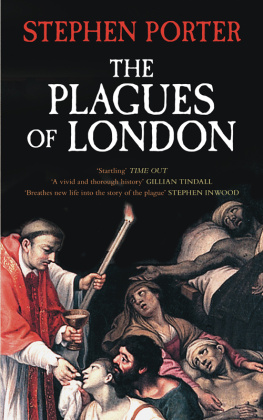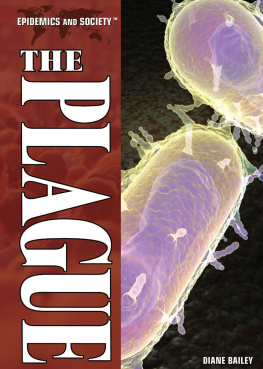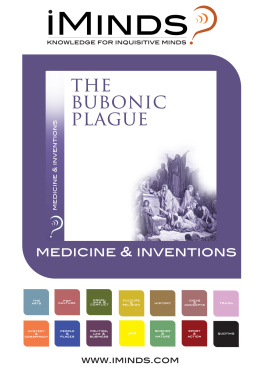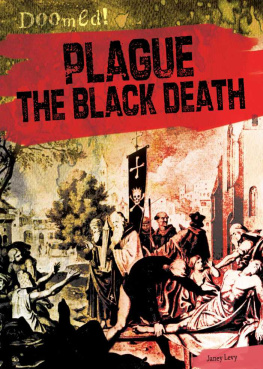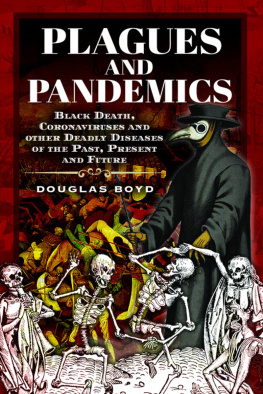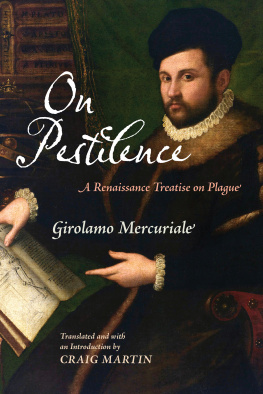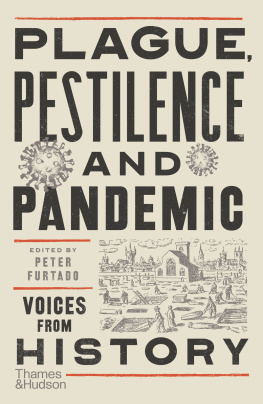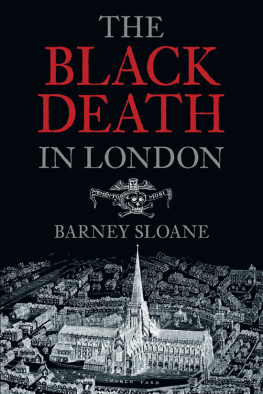THE
PLAGUES
OF LONDON
STEPHEN PORTER
THE
PLAGUES
OF LONDON

This edition first published in 2008
The History Press
The Mill, Brimscombe Port
Stroud, Gloucestershire, GL5 2QG
www.thehistorypress.co.uk
This ebook edition first published in 2013
All rights reserved
Stephen Porter, 2005, 2008, 2013
The right of Stephen Porter to be identified as the Author of this work has been asserted in accordance with the Copyrights, Designs and Patents Act 1988.
This ebook is copyright material and must not be copied, reproduced, transferred, distributed, leased, licensed or publicly performed or used in any way except as specifically permitted in writing by the publishers, as allowed under the terms and conditions under which it was purchased or as strictly permitted by applicable copyright law. Any unauthorised distribution or use of this text may be a direct infringement of the authors and publishers rights, and those responsible may be liable in law accordingly.
EPUB ISBN 978 0 7524 9653 5
Original typesetting by The History Press
Contents
About the Author
S tephen Porter, until his recent retirement, worked for over seventeen years for the Survey of London, a century-old project devoted to the history of Londons built environment. His other books include The Great Plague, The Great Fire of London, London & the Civil War and Destruction in the English Civil Wars. He lives in Stratford-Upon-Avon.
Acknowledgements
K ind invitations from Professor Frank Cox, to give a lecture at Gresham College on plague in early modern London, Alison Bailey, to submit an article on plague for The Biologist, and Dr Julian Davies, to speak on the topic of St Giles-in-the-Fields in the Great Plague, helped to focus my thoughts, just at the time when my editor at Tempus, Jonathan Reeve, was persuading me that a book on the subject was needed. I am very grateful to all of them for their encouragement. Kenneth Gage of the Centers for Disease Control and Prevention and Bill White of the Museum of London Archaeology Service kindly gave advice on the aetiology of plague. Gillian Tindalls careful reading of the text and Christabel Scaifes skilful editing saved me from some unnecessary errors and Derek Kendall gave invaluable help with some of the illustrations. My wife Carolyn was good enough to follow my progress and make sound suggestions on the text. The pestilence has taken us from London to Leiden, from Nijmegen to Venice, and she has been startled to discover just how stimulating plague can be.
A Most Dreadful Disease
O f all the diseases that afflicted Europe in the premodern period, plague made the greatest impact. Devastating and feared, it had a profound effect on the outlook and behaviour of Europeans for more than 400 years after its calamitous onset in the mid-fourteenth century. Its pre-eminence among diseases was such that plague, or the pestilence, came to be used to describe not only contagious epidemic diseases but any affliction or calamity, or as a curse upon others: A plague on both your houses.
In King James Bible of 1611, plague was both a manifestation of Gods anger behold, with a great plague will the Lord smite thy people, and thy children, and thy wives, and all thy goods and a catastrophe that could strike a city: The sword is without, and the pestilence and the famine within: he that is in the field shall die with the sword; and he that is in the city, famine and pestilence shall devour him. It is hardly surprising that this most dreaded of diseases developed a symbolic significance, given the scale of the mortality during the periodic epidemics, and the sheer foulness of the disorder.
The symptoms of bubonic plague included a high fever, headaches, vomiting, the painful swelling of the lymph nodes, especially in the groin and armpits and on the neck, forming the buboes which give the disease its name, and excruciatingly painful blotches or carbuncles up to an inch across, caused by haemorrhaging beneath the skin. These blotches were often described by contemporaries as tokens, and plague as spotted death. The haemorrhaging produced neurological and psychological effects, with the victims often suffering delirium; screaming and running wildly around the streets. The symptoms in themselves and their all too visible effects were enough to produce fear and revulsion. These were intensified by the remorselessness with which plague spread, the speed of death which generally followed the first appearance of symptoms within a few days, and no longer than a week and the high fatality rate; Scarrus in Shakespeares Antony and Cleopatra refers to the tokend pestilence where death is sure. This was a (perhaps understandable) exaggeration, for between twenty and thirty per cent of those who contracted the disease survived, usually after their buboes had burst. And they had to burst outwards; if they burst inwards then the victim died of septic shock almost immediately.
Ambrose Barnes was an apprentice to a merchant in Newcastle-upon-Tyne during an outbreak of plague in the late 1640s, and later recalled his awful experience, writing in the third person. The disease made for some months an horrible devastation, with the bodies collected at night and taken in carts to be buried outside the city. Eventually, one of the merchants maids was taken ill, but the other continued to serve meals to Barnes and his master, until Barnes noticed that she was showing some dangerous symptoms. His master left abruptly and took ship for Hamburg; both of the maids died, within a few hours of each other, and Barnes fell ill. He was left alone in an empty house without any living creature besides himself. Food was placed outside the street door for him to collect. In this hideous lonely manner, he spent severall dayes and nights, but God was with him. A huge tumour rose upon his neck behind, the suppuration whereof, physitions were of opinion, saved his life.
Epidemics of other diseases struck from time to time and some caused high levels of mortality, but plague made the greatest impact on society and was the most feared. In 1603, James Balmford, minister of St Olaves, Southwark, described plague as more daungerously contagious being mortall, than the leprosie. Because of the foulness of the disease and the numbers of its victims his contemporary Thomas Dekker gave plague
a Preheminence above all others... none being able to match it, for Violence, Strength, Incertainty, Suttlety, Catching, Universality, and Desolation, it is called the Sicknesse. As if it were, the onely Sicknesse, or the Sicknesse of Sicknesse, as it is indeede.
It has retained its reputation as the deadliest of diseases and is used as a metaphor for disasters or extremely testing circumstances. Discussing the diplomatic exchanges which preceded the Iraq war in 2003, Sir Kieran Prendergast, head of the United Nations department for Political Affairs, described the Security Council as being faced with a choice between cholera and plague, and commented that You always prefer cholera to the plague, because cholera is survivable and the plague much less so.
The earliest recorded disease bearing a resemblance to plague erupted at Athens in the fifth century BC, but the cause of that epidemic is uncertain. The evolution of the plague bacterium has recently been dated to between 20,000 and 1,500 years ago. Within this long range, the more recent date fits the chronology of the first of the three pandemics, the Plague of Justinian, which struck Egypt in 541 and spread to western Europe in the following year, with periodic epidemics until the 760s. Justinian I was emperor of the eastern Roman Empire and Procopius, secretary to his general, Count Belisarius, described the symptoms of the disease. It began with a fever, which was followed by the eruption of swellings below the abdomen, in the armpit, by the ears and on the thigh, and it produced a deep coma or, in other cases, violent delirium. Those victims whose bodies developed black pustules died shortly afterwards, while those whose tumours burst and discharged pus survived the disease. Justinian himself was infected but lived. The extent of the mortality, an estimated 40 million deaths, can be explained by the impact of this newly evolved bacterium on a population without any specific immunity, induced in response to previous infection, and enfeebled by the effects of several years of disastrous harvests a result of low levels of sunlight caused by excessive dust in the atmosphere.
Next page
